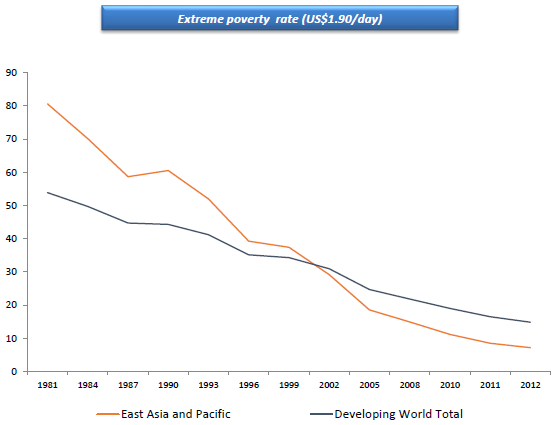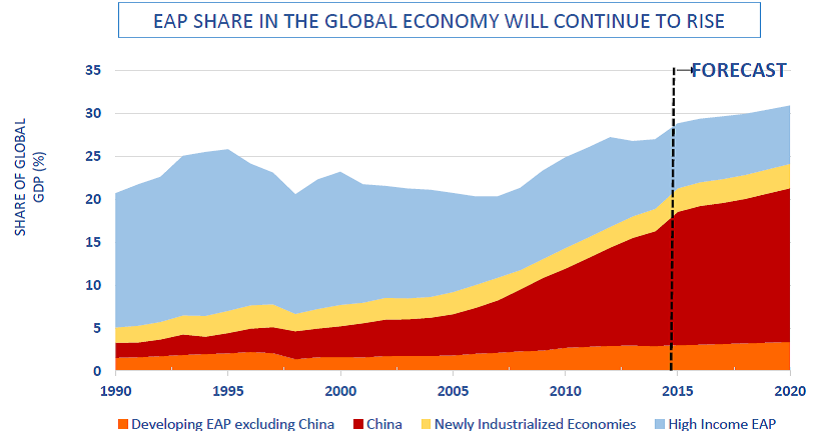If dealt well, the challenging megatrends in the emerging economies in East Asia and the Pacific (EAP) can be translated into opportunities for the region.

Known for its consortium of diverse countries, the EAP region is one of the key drivers of the world economy and accounts for nearly two-fifths of the global economic growth.
As the world witnesses the fastest poverty reduction in this region, from 80 per cent in 1981 to an estimated 5.4 per cent in 2014, such achievement has made several countries look up to East Asia, said Victoria Kwakwa, World Bank Vice President for EAP, in a public lecture at the Lee Kuan Yew School of Public Policy, National University of Singapore.
And now the region is geared up to reach its goal of three per cent of extreme poverty by 2020, which is elimination of extreme poverty, said Kwakwa.
 Despite this remarkable progress, the region is rife with challenges such as the uneven economic and social growth. Also, a significant number of people still live on the poverty line and are highly vulnerable to fall back into extreme poverty if hit by economic, climate or health shocks.
Despite this remarkable progress, the region is rife with challenges such as the uneven economic and social growth. Also, a significant number of people still live on the poverty line and are highly vulnerable to fall back into extreme poverty if hit by economic, climate or health shocks.
An eye on the megatrends
Against this challenging backdrop, Kwakwa shared five megatrends that have been reverberating and influencing the dynamics of the region.
EAP's rising prominence in global growth
As EAP's contribution to the global economy tripled from nearly 6.6 per cent in 2000 to 18 per cent in 2015, Kwakwa projected that the future growth of this region is expected to be resilient, and by 2050 it will contribute to 50 per cent of the global GDP.

However, weak global trade, persistently low commodity prices and a slowdown in both high-income and emerging markets might come in the way. EAP countries need to have sound monetary and fiscal policies to enhance their credibility and reduce their exposure to global and regional risks, urged Kwakwa.
Escalating urbanisation
Although the developing countries in this region are going through rapid urbanisation, the likely constraints that they will be facing are land availability, housing and services.

Singapore has been extremely successful in effectively managing its urbanisation process through integrated planning, housing densification and accessibility to services like health, education and transportation, lauded Kwakwa.
Staggering growth of the middle class
With a 17 per cent yearly increase, the middle class in this region is likely to touch one billion by 2030.

However, the needs of this rising class have not been necessarily supported by appropriate provisions of high-quality public services, such as education, quality housing, clean water and sanitation facilities. Fifteen per cent of the region's middle class excluding China lack access to one or more of these basic public goods, said Kwakwa.
She suggested that the right public responses to better infrastructure and public service accessibility could eventually lead to more inclusive and competitive growth.
Silver tsunami
EAP is also at the forefront of an increasingly ageing global population. For many countries in the region that are not yet high-income, the prospect of getting old before getting rich could have dire consequences on their social and economic development, warned Kwakwa.
Hence, structural reforms need to be introduced in the pension and healthcare systems to promote healthy and productive ageing.
Climate change
This region bears the brunt of 70 per cent of the world's natural disasters. While it accounts for one-third of the world's CO2 emissions and 60 per cent of global coal consumption, EAP, especially China, is playing a critical role in advancing the climate change agenda.
Twenty-three out of 28 EAP countries ratified the Paris agreement last year, which shows the region's commitment to address the emissions challenge, said Kwakwa.
Reaping benefits out of the megatrends
Although these megatrends have numerous challenges attached, if handled well, they can generate enormous opportunities for the citizens and communities of the region.
Urbanisation, for instance, if systematically carried out, can explore economies of scale through densification of people and services in one place, which in turn would also spur inclusive economic growth, said Kwakwa.
In addition, she suggested that although the region is facing the risk of an ageing population, the fact that these elderly individuals can still be productive is an opportunity in itself. Countries can fully optimise on their human capital by increasing the retirement age, and also expanding female labour force participation through social security and labour reforms.
Overall, emerging countries in the EAP region will need to have appropriate public policy tools and reforms in place to make the most out of these megatrends.
Displaying optimism, Kwakwa said: EAP has a very promising future as long as it finds the right methodology to maximise the opportunities of these megatrends, while at the same time minimising the risks associated with it.
This is an event coverage piece for the public lecture, Megatrends in the Emerging Economies of East Asia and the Pacific: A View from the World Bank which was held at the LKY School on 9 December2016.